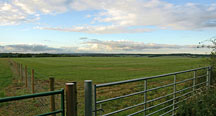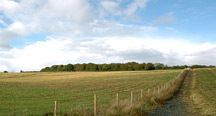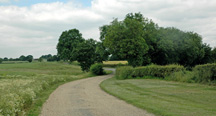Greenbelt Land for Sale
"We need new houses more than we need wetlands", says James Heartfield
Caroline Spelman, the UK Conservative Party's shadow local government secretary, has attacked the New Labour government for turning the Green Belt into more of an elastic band, increasing it where there is no demand for new building and loosening it where there is. But that, surely, is what the government should be doing. Planning regulations ought to change to meet people's needs.
However, there is a bigger problem with the Green Belt: it is based on the archaic idea that town and countryside must be kept apart, and it stirs deep anxieties about change and about the proximity of other people.
There are 1.5million hectares (3.8million acres) that are designated 'Green Belt' - around 12 per cent of England - plus a further 156,600 hectares in Scotland. The first Green Belt in modern times was created by the London and Home Counties Green Belt Act of 1938. Since then, Green Belts have been established around Glasgow, Edinburgh, Aberdeen, Greater Manchester, Merseyside and the West Midlands, as well as many other smaller towns, under then Tory minister Duncan Sandys' 'historic circular' of 1955 'inviting local planning authorities to consider the establishment of green belts' (1).
Green Belts are 'areas of land intended to be left open and protected from inappropriate development'. Their purpose is 'to check the sprawl of largely built-up areas, safeguard surrounding countryside from encroachment' and 'prevent neighbouring towns from merging', according to the government (2). 'We have a clear duty to do all we can to prevent the further unrestricted sprawl of the great cities', said minister Duncan Sandys (who was later denounced by Edward Hearth as the 'unacceptable face of capitalism') (3).
Today, the New Labour government's proposals to 'streamline planning proposals' were shot down in flames by Guardian columnist Ros Coward as 'a green light to the developers'. 'There is virtually no mention of environmental protection, nature conservation, or Green Belt', complained Coward (4). Forty years earlier, housing minister Richard Crossmann 'began to realise what a sacred cow the Green Belt had become in progressive circles', when he agreed the development of a model village, Ash Green in Hartley, Kent (5). Though quite why progressives are so determined to protect the status quo is hard to understand. You would think that it would be a good idea to build people the houses they need, but apparently wetlands are more important.
The current discussion arises because of the pressure on the Green Belt from developers - though as government minister Phil Woolas explains, in fact New Labour has built on much less of it than did the Conservatives before them. That in itself is nothing to boast about: new building overall has been much lower under this administration than under any other since the war.
What has happened is that agricultural output has declined markedly over recent years, partly because much more is produced on much less land under new techniques, and partly because the EU has been winding down farming through the 'set-aside scheme'. Around three quarters of Britain was ear-marked for farming after the war, which is pretty much as it is today, except that around a third of that is surplus to requirements.
As Britain's housing stock ages, the temptation is there to build more homes on the surplus land. And why not?
The Green-Belt scaremongers warn that the countryside will be concreted over. But just 11 per cent of land in the UK is taken up by roads and houses. You could literally double the size of all our towns and cities - which would be impossible under present conditions - and that would reduce the countryside by less than a sixth. Like trying to paint a barn with a half-litre pot of paint, it is not possible to stretch the population's living quarters over the whole of the countryside.
The Green Belt is an artificial attempt to retain a division between town and country that was made redundant by changes in transportation and farming methods years ago. Economist Alan Evans explains that with the popularity of the car, 'for the first time people other than the very rich did not have to live within walking distance of jobs, shops, or public transport' (6). More than that, increasing incomes have meant that people's expectations of greater living room, and access to green spaces, have increased.
But keeping the Green Belt in the face of new housing demand has the perverse effect of recreating the conditions of the Victorian Slum. All over London, the policy of only building on already developed (or 'brownfield') land is leading to new overcrowding. Every spare scrap of land is being used to cram in more five-storey apartments.
The policy drafted by Richard Rogers' urban task force flies in the face of people's aspirations. A Council for the Protection of Rural England survey (whose findings they tried to suppress) found that, DINKY metrosexuals notwithstanding, suburban bungalows are top of the housing wants list. Indeed, 43 per cent of the population already live in suburban areas of Britain (7).
That might sound like anathema to today's radicals, but they have forgotten that the abolition of the division between town and country was the original goal of radicals from Frederick Engels to Leon Trotsky. Keeping the proles from spilling over into the countryside was the preoccupation of high Tories like Churchill's son-in-law Duncan Sandys.
There is no reason that people should live cheek-by-jowl, now that modern transport has made more dispersed living possible. In fact, our larger cities are already great conurbations, interspersed with fields and parks. Many people who work in London go to bed in Brighton or Oxford. Suburbs that used to be counted part of Essex, like Walthamstow, are today called 'Greater London'.
We ought to be concreting over the Green Belt, and turfing over lots of our cities, too. The town/country division that the Green Belt artificially recreates belongs to the nineteenth century, not the twenty-first.




